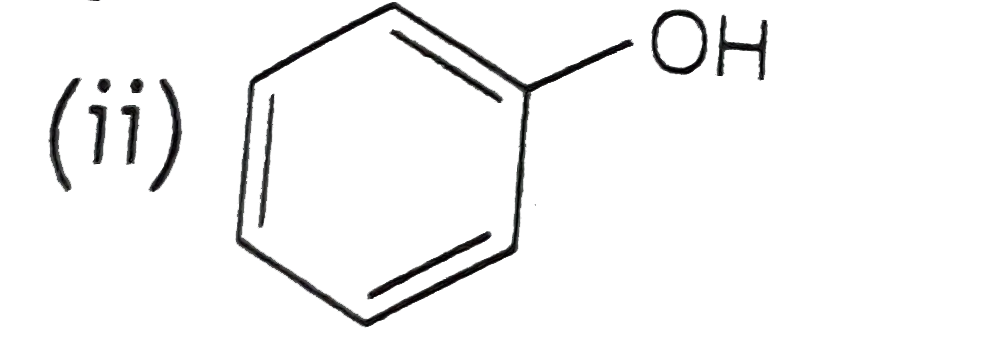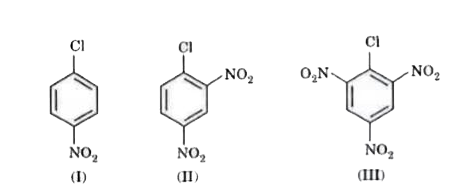Complete Solutions to NCERT examplar Problems (Short Answer Type Questions) of chapter HALOALKANES AND HALOARENES of Class 12 book with complete answers and questions
| Class 12 | CHEMISTRY |
| Chapter | HALOALKANES AND HALOARENES |
| MODERN PUBLICATION | NCERT examplar Problems (Short Answer Type Questions) |
| Number Of Questions | 21 |
| Academic Year | 2023-24 |
Aryl chlorides and bromides can be easily prepared by electrophilic substitution of arenas with chlorine and bromine respectively in the presence of Lewis acid catalyst. But why does preparation of aryl iodides requires presence of an oxidising agent?
View SolutionOut of o- and p-dibromobenzene which one has higher melting point and why?
View SolutionWhich of the compounds will react faster in `S_(N)1` reaction with `""^(-)OH` ion?
`CH_(3)-CH_(2)-ClorC_(6)H_(5)-CH_(2)-Cl`
View SolutionWhy iodoform has appreciable antiseptic property?
View SolutionHaloarenas are less reactive than haloalkanes and haloalkenes. Explain.
View SolutionDiscuss the role of Lewiis acids in the preparation of aryl bromides and chlorides in the dark.
View SolutionWhich of the following compounds (i) and (ii) will not react with a mixture of NaBr and `H_(2)SO_(4)`. Explain why ?
(i) `CH_(3)CH_(2)CH_(2)OH` (ii)
View SolutionAllyl chloride is hydrolysed more readily than n-propyl chloride. Why ?
View SolutionWhy is it necessary to avoid even traces of moisture during the use of a Grignard reagent?
View SolutionHow do polar solvents help in the first step in `S_(N)1` mechanism?
View SolutionWrite a test to detect the presence of double bond in a molecule.
View SolutionDiphenyls are potential threat to the envioronment. How are these produced from aryl halides?
View SolutionWhat are the IUPAC names of the insecticide DDT and benzene hexachloride? Why is their use banned in India and other countries?
View SolutionElimination reaction (especially `beta` - elimination) are as common as the nucleophilic substitution reaction in case of alkyl halides. Specify the reagents used in both cases.
View SolutionHow will you obtain monobromobenzene from aniline ?
View SolutionAryl halides are extremely less reactive towards nucleophilie substitution. Predict and explain the order of reactivity of the following compounds towards nucleophilic substitution:

View Solutiontert-Butylbromide reacts with aq. NaOH by `S_(N)1` mechanism while n-butylbromide reacts by `S_(N)1` mechanism. Why?
View SolutionPredict the major product formed when HCl is added to isobutylene, Explain the mechanism involved.
View SolutionDiscuss the nature of C-X bond in the haloarenes.
View SolutionHow can you obtain iodoethane from ethanol when no other iodine containing reagent except NAI is available in the laboratery?
View SolutionCyanide ion acts as an ambident nucleophille. From which end it acts as a strong nucleophile in aqueous medium? Give reason for your answer.
View Solution
NCERT examplar Problems (Short Answer Type Questions) questions and complete solutions for chapter HALOALKANES AND HALOARENES of MODERN PUBLISHERS CHEMISTRY (HINGLISH) of Class 12
All Exercises from MODERN PUBLICATION Class 12 CHEMISTRY HALOALKANES AND HALOARENES
- A. MULTIPLE CHOICE QUESTIONS (with only one correct answer)
- B. MULTIPLE CHOICE QUESTIONS (from competitive Examinations)
- C. MULTIPLE CHOICE QUESTIONS (with more than one correct answers)
- CONCEPTUAL QUESTIONS
- D. MULTIPLE CHOICE QUESTIONS (based on the given passage / comprehension)
- HIGHER ORDER THINKING SKILLS
- Integer Type Questions
- MEMORY TEST (A. Say True or False)
- MEMORY TEST (B. Complete the missing links)
- MEMORY TEST (C. Choose the correct alternative)
- NCERT examplar Problems (Assertion and Reason Type Questions)
- NCERT examplar Problems (Matching Type Questions)
- NCERT examplar Problems (Multiple Choice Questions (Type-I))
- NCERT examplar Problems (Multiple Choice Questions (Type-II))
- NCERT examplar Problems (Short Answer Type Questions)
- NCERT In-text Questions
- NCERT Textbooks Exercise
- NCERT Textbooks Exercises
- PRACTICE PROBLEMS
- REVISION EXERCISE (Long Answer Questions)
- REVISION EXERCISE (Objective Questions) (Assertion Reason questions)
- REVISION EXERCISE (Objective Questions) (Multiple choice questions)
- REVISION EXERCISE (Objective Questions) (Passage based questions)
- REVISION EXERCISE (Short Answer Questions)
- REVISION EXERCISE (Short Answer Questions) (CBSE Qs....)
- REVISION EXERCISE (Very short Answer Questions)
- REVISION EXERCISE (Very short Answer Questions) (CBSE Qs....)
- SOLVED EXAMPLES
- UNIT PRACTICE TEST